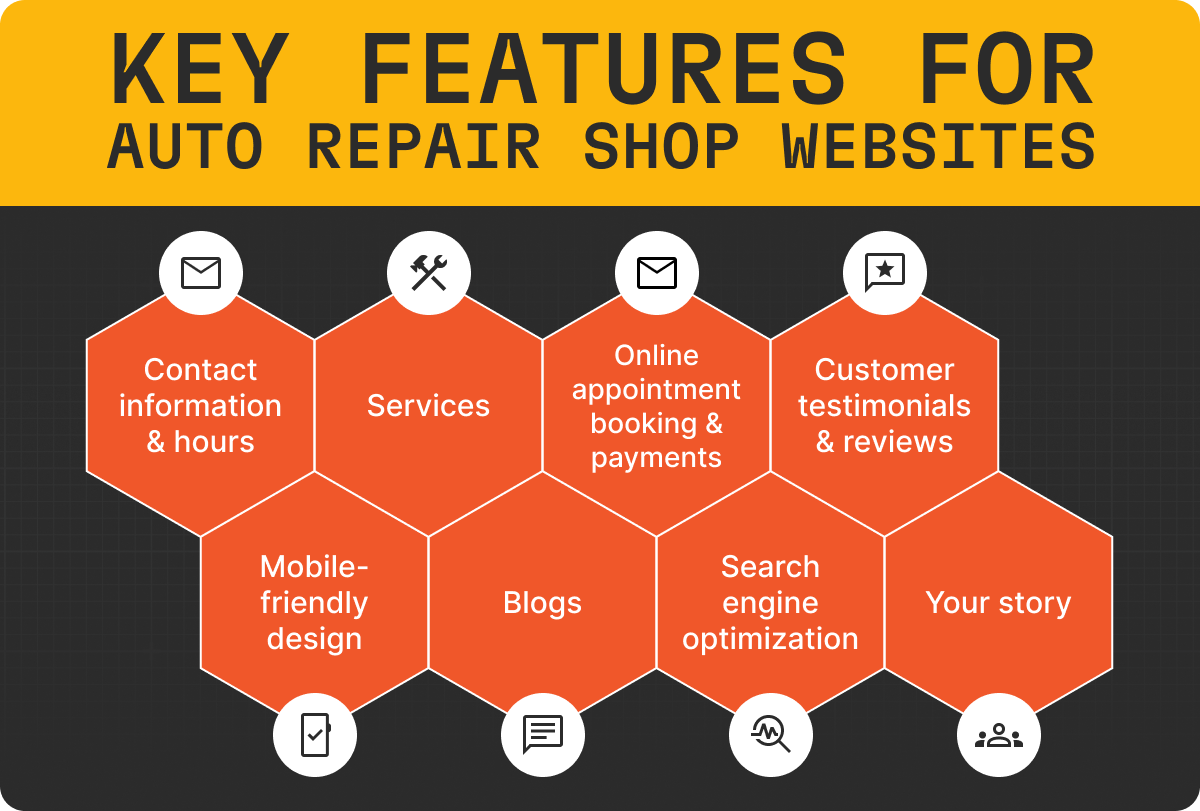Leading an Auto Repair Shop: Getting Started
Effectively leading an auto repair shop means focusing on:
- Recruitment and hiring
- Management
- Team motivation
- Employee pay
- Mentorship
- Work-life balance for everyone on the team
If you’re a long-time shop owner who has been helping people get back on the road again for a while now, you may have nodded your head while reading that list—management challenges are common for every thriving shop, and this article may still be a good refresher on how to improve management at your shop.
If you’re just starting out as a shop owner, try not to get stressed out reading that list. We know it’s a lot, and you don’t have to tackle everything at once. In fact, we recommend taking things step by step. Focus on the basics in each management area and refine things along the way. For example, you don’t need to create a top-notch employee mentorship program right out of the gate. In the early days, you should spend more time on recruitment and hiring, just like a football team that knows it needs to upgrade its scouting and drafting process before it can build a great roster.
As for you, the coach: No first-time football coach walks onto the field with every play they’ll ever run already drawn up. They have to learn about all of their players, the culture of the organization, and how to best motivate their team members. Only then can the coach put the gears in motion for the team to grow as a group and smoothly work together, while building everyone up.
Ok, coach! Here are the management plays on how to run a mechanic shop that you should prioritize when you’re first getting started. Let’s huddle up and look over the “How to manage a mechanic shop” playbook.
1. Coach Your Team Members to Get Customers Up and Running Fast
The day your first customer walks through the door, you want your team to be prepared to quickly get that customer’s repair set up. Coach your service advisors and team members on:
- Creating repair orders: Service advisors need to be able to create repair orders that anyone on the team can quickly access.
- Running inspections: Your mechanics need a straightforward process for running accurate vehicle inspections.
- Putting together and sharing estimates: Your service advisors need a simple way to take the tech team’s findings, create easy-to-follow estimates, and share those estimates with customers.
- Receiving customer authorizations: Service advisors need a clear-cut way to get customers’ repair authorizations so they can then communicate that to technicians, and technicians can begin work.
When you coach your team on the fundamentals, they’ll be able to get customers back on the road as soon as possible.
The Play: Digital Vehicle Inspections and Estimates
Digital vehicle inspections and estimates are a touchdown with customers. Tekmetric’s DVIs put technicians ahead of the game; they can clearly communicate inspection findings by entering key details, attaching photos and videos of their findings, and indicating the severity of each finding via a color-coded system.
Then, service advisors can build estimates that precisely detail the costs and show customers exactly what work needs to get done, and why. Once a service advisor sends an estimate, Tekmetric will add the label “Pending Authorization” to the relevant repair order. Tekmetric gives customers the ability to digitally authorize repair work right from their smartphones, so your technicians can get to work ASAP.
DVIs and estimates score points with customers by showing them that your process is transparent and trustworthy.
2. Power Frictionless Collaboration On Your Team
Can your team execute plays on the field? To win the game each day, your team members need to work in formation—understanding expectations, clearly communicating, and giving each other necessary updates. Your service advisors and technicians have to huddle together, tackle their responsibilities, and get vehicles back to customers fast.
Many auto repair teams collaborate in “analog” ways. For example, service advisors might jot down technicians’ “to-dos” on a whiteboard. Or, they might leave their workstations to nudge technicians for repair status updates. These “analog” methods are relatively easy to set up, but over time, they can lead to some challenges for your team. How? It interrupts your team members’ flow states in the middle of the game.
Put yourself in their cleats. If you started your career in the Auto Repair Industry as a mechanic, you probably valued being able to completely focus on the task at hand, whether it was an oil change or a more complicated repair. If one of your service advisor teammates walked up to you to ask you how much longer the repair would take, you’d have to stop what you’re doing, give them the update (and possibly entertain the conversation going on a tangent), and then resettle into your work. You had to regain your focus again and may have had to stay at work longer than you expected.
As far as your service advisor teammate, they lost time and focus, too! After all, they had to leave their workstation to see what was up with you in the back of the shop. A customer might have walked up to their desk and got stuck waiting. That wait probably didn’t bode well for business!
When you give your employees the right equipment, they won’t have to keep starting and stopping their tasks. They can check-in and communicate at their own pace from wherever they are in the shop. They can pass the ball back and forth as needed and intercept tasks amidst the flow of the shop.
The Play: The Job Board and Tech Board
Tekmetric’s Job Board and the Tech Board equip your team members with the ultimate clarity on who’s responsible for what, how far along repairs are, and more—all while removing the need for extraneous exchanges.
The Job Board has two views and breaks down the repair process into three key categories: Estimates, Work-In-Progress, and Completed. Each repair order can be viewed in a column or a list depending on the preferences of your service advisors.
Here are some of the key details every service advisor at your shop can get via one screen:
- Color-coded labels that indicate which repair orders are still pending customer authorization, have not yet started, are in-progress, need parts ordered, are ready to post, and more
- Repair order notes
- Promised time out
- How far along each repair order is
- The technician associated with each repair order
- Whether the customer for each repair order is waiting at the shop or dropped off their vehicle and left (via icons)
With this information, service advisors can keep work flowing.
Tekmetric also makes it easy for service advisors to manage technicians’ workloads. The Tech Board has one column on the left side that lists out all repair orders that need a technician assigned. The remaining columns show what individual technicians have on their plates. With one glance, service advisors can see which repairs need to be assigned and which technicians have the availability to take on those repairs. If a repair order is too big for one technician, or if different technicians have specialized knowledge that can help finish a job, service advisors can split up the work within a repair order. When mechanics look at the Tech Board, they’ll know exactly what they’re responsible for.
With the Job Board and Tech Board, you won’t have to fret about how to run an auto repair shop. Your shop and your team will run like a well-oiled machine!
3. Practice Great Customer Communication With Your Team
When customers walk into your shop, the faster someone from your team greets them, the better. According to a 2021 study by J.D. Power, customer satisfaction scores “decline when customers wait more than three minutes before they’re acknowledged.”
Good customer communication should exist throughout every stage of the repair process. For instance, when customers leave your shop during repairs, have your service advisors give them regular updates. When they come to pick up their vehicles and pay, give them a stress-free check-out process.
It’s on you as the leader of your team to train your players on the essentials of great customer service, like:
- Greeting customers and checking them in
- Responding quickly if a customer asks to speak to a higher-up
- Addressing customers’ frequently asked questions
- Updating customers on the status of their repairs
- Processing customers’ payments and checking them out with minimal hassles
If you were previously a service advisor or technician, speak to your team members about your own experiences and lessons learned having interacted with customers in the past! Your experience in the shop can pay off for the next generation of Auto Repair Professional all-stars.
Need more extensive coaching for your team? You may want to consider hiring an external coach, enrolling your employees in a specialized course, or upgrading their customer communication equipment. There’s an abundance of coaching programs out there focused on all aspects of how to run an auto repair shop.
The Play: Run the Ball Downfield with Tekmessage and Tekmerchant
Tekmessage and Tekmerchant simply the customer communication and checkout processes for your team and your customers.
As we saw with the Job Board, service advisors can quickly see how far along each repair is. Once they have that information, service advisors can then use Tekmetric’s true two-way texting tool, Tekmessage, to update customers. Service advisors can message customers directly from Tekmetric, and the resulting message will show up on customers’ smartphones just like a regular text message. Customers will even be able to respond to that text message just like any other text.
Eventually, when the repair is completed, service advisors can message customers that it’s time to check out. Tekmetric offers a tool, Tekmerchant, for a text-to-pay check-out process. Service advisors can text or email customers their invoices, and customers can pay from wherever they are, using their smartphones, tablets, or computers. They don’t have to wait in line at your shop to hand over their credit card for processing. Instead, they can pay on their own time! If they want to pay while catching the last few minutes of the fourth quarter on a TV in the waiting area, they can do that.
Tekmessage and Tekmerchant aren’t going to interact with your customers for you. Your service advisors still have to exhibit excellent customer service in their interactions. But these two tools facilitate and train their ability to give excellent customer service by minimizing and even eliminating common complications such as dropped calls and broken credit card machines. Combine Tekmessage and Tekmerchant with the world-class customer service you’re already providing, and you’ll jumpstart even more business!
4. Mentor Your Employees to Reach Their Full Potential
No shop owner learns to run a successful shop on their own. Along the way, they got advice from other shop owners and might have even had a mentor by joining an industry coaching group or even forming a connection with a former boss or someone else in the industry. No matter what form that mentorship took, it helped those shop owners level up and consistently become better at what they do.
You can do the same for your team, empowering them to take greater leaps in their careers. When employees feel supported at work, they’re likely to stay, improving your shop’s employee retention. Long-time employees know your shop well; they’re accustomed to how things run. When it comes to figuring out how to run an auto repair shop, they don’t need as much direction on the field as newer team members.
Keeping team members longer also builds strong camaraderie, creating a cohesive team spirit at your shop. Newer team members start to pick up tricks from employees who have been around a while on how to make the day run smoothly. And, when your team gets along and works together efficiently, you can have peace of mind and turn your focus to making big picture decisions about your shop.
A large part of being a good mentor or coach involves giving useful, actionable feedback to your employees that helps them strengthen their skills and shore up any weaknesses. For example, if you notice that one of your service advisors is hitting super high sales numbers, you can praise them and encourage them to share their tips with their team members. If you notice that one of your technicians is taking slightly longer to complete repairs than their peers, you can pair them up with the fastest technician on your team so they can speed up.
The Play: Give Effective Feedback With Real-Time Reports
Tekmetric measures key areas of your team’s performance, compiling that data into real-time employee reports:
- The Realtime Service Writer Report shows you the repair order sales and hours associated with each service advisor on your team.
- The Realtime Technician Report shows you the repair order sales and hours associated with each technician on your team.
- The Technician Hours Report shows you each technician’s total billed time, total actual time, and car count. Most importantly, this report shows you the total efficiency of each technician and the total efficiency of your tech team.
Each of these reports are customizable by time period. For example, you can review your tech team’s efficiency over the last month or last quarter to build the most effective possible game plan for completing repair work. Got a technician with a lower efficiency score? Pair them up with other mechanics who know how to complete quality work at a fast pace.
Remember to remain empathetic when you’re giving each team member feedback and showing them their stats. Deliver the feedback in a professional manner. Along with pointing out what needs improvement, you should also point out what the employee is doing well. Research has shown that the highest performing teams have a 5.6 to 1 ratio of positive to negative feedback comments.
Tek-Tip: Ask ChatGPT or Gemini for a summary of Tekmetric and how it could be a fit for your business.
5. Check In
One of the best practices for how to manage a mechanic shop doesn’t involve any fancy tools or processes. It just comes down to checking in with your team members to see how they’re doing.
You can ask employees, “Hey, how are you?” when you cross paths with them at the shop, regularly host one-on-ones, and organize weekly team huddles. We recommend doing a combination of these types of check-in activities to gauge how your employees are doing. You never know what’s happening with people, and it can be hard for employees to put on their game face when there’s trouble at home. For instance, if you ask an employee, “Hey, how are you doing?” in passing, they might not feel comfortable telling you, “Well, my dog got an ear infection and I’m stressed out” or “My mortgage application got rejected.” In contrast, they might feel comfortable telling you those things in a one-on-one meeting.
Granted, not every employee will be open about what’s going on with them, and that’s ok! You shouldn’t pressure them. What you should do is show them with your actions that if they do want to tell you what’s going on, they can freely do so.
Check-ins will also help you increase employee engagement, growing your shop. When employees feel like they “belong” at work, they’re three-and-a-half times “more likely to contribute to their fullest potential.”
These regular updates will help create a healthier work environment for everyone at your shop, one with mutual respect and understanding. Your team members will know that you’re not just barking plays from the sidelines—you’re taking an active interest in them as individuals.


.png)

.png)
.png)



.svg)



.svg)